Nowadays, business owners can’t even think of surviving the competition without having a website that performs well in their SERPs.
That means if you want to improve your brand value, make your website visible in the SERPs, reach more audiences, and lead them to buy your product or services; you must rank well in the search engines. And to ensure all these factors, you need to ensure that your digital marketing efforts and SEO practices are working well.
This is where an SEO audit comes into play. But, how does SEO audit help boost Google ranking?
An SEO audit is a process that helps you to identify or determine how your site is performing, what your site lacks, and processes to optimize your site to perform better. It doesn’t end here; there are many more related to an SEO audit, which we’ll explore in this guide. So, if you want to learn more, let’s dive into this guide.
How Does SEO Audit Help Boost Google Ranking?
In this age of digital marketing, SEO not only ensures top rankings on Google but also ensures how people find your business across the Internet. SEO is huge; there are almost 200+ factors related to it, and these factors keep changing year by year.
Only with the right roadmap you can ensure reaching your ultimate goal and reaching the top position with a well-optimized website. And the process of creating the SEO roadmap starts with the Website SEO audit services.
Running an SEO audit means analyzing your web presence to see how your website performs. It is a way to identify whether you’re using SEO best practices or not. Also, it determines all the issues of your site that hinder your site from performing well in the SERP.
A successful SEO audit goes deep into all SEO components, then analyzes and checks them properly for performance. In general, an SEO audit can find out the following issues-
- Website structure weaknesses,
- Content optimization issues and content gaps,
- Technical errors,
- User experience,
- SEO weaknesses
- All the on-page and off-page issues
- And many more…..
Through SEO website audit services, you can get all your website’s insights. Once you find your site’s issues and where you’re missing out, you can strategize new plans and make changes to your site and SEO processes to fix all these issues. And this way, an SEO audit can help you to rank well in the SERP and reach optimum traffic.
What to Consider When Running an SEO Audit?
SEO audit is a huge process where you have to plan it comprehensively. Therefore, whenever conducting an SEO audit, you need to consider several things.
Only then you can get a high-level view of where you’re standing right now with your SEO strategies, where you need to focus on, what optimization you should implement, and where you can go. So, here’s what you should consider while running an SEO audit-
- You have to make sure that you’re touching all the components or SEO factors that may affect your search ranking and not missing out on any essential factors.
- It should be comprehensive and cover both structural and content components.
- Focus on presenting the SEO audit results or findings as simply as possible. This way, your other team members will also find it easy to understand the report.
- Make sure to draw a link between the SEO audit findings, goals, strategies, revenues, and the entire website’s SEO performance.
- You must have a distinct and clear strategy to fix the issues. Here you should plan the budget as well as prioritize the work to ensure a smooth process. You and all your team members should follow the roadmap to reach your objectives.
- Never make any rush while conducting an SEO audit. You need to be patient while examining all the SEO aspects as they will require a longer time. This way, you can get accurate results about how your site is performing.
Tools Required for the SEO Audit Process
The best part about SEO audit is, there are some great tools that can help you find the issues of your site and provide recommendations to make improvements.
Free SEO Audit Tools:
Paid SEO Audit Tools:
How to Perform an SEO Audit?
While conducting an SEO audit, you should keep in mind that there are 200+ factors that work behind a site’s ranking. To ensure a proper SEO audit, you should make sure that you’re covering every aspect of SEO.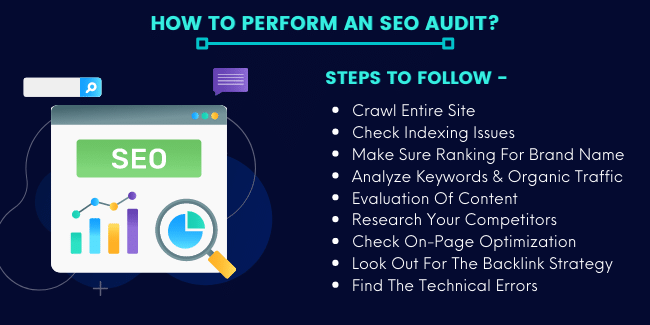
Generally, while performing an SEO audit, you should follow a thorough step-by-step process. So, let’s figure out what the processes or checklists are-
1. Crawl Your Entire Site
The first and foremost step is crawling your entire site. It helps to identify the issues related to the SEO strategy of your site. You can use the above tools to crawl your site; it will save a huge time.
Once finished, you’ll get a breakdown of multiple components that will help you identify the issues. Usually, the report consists of all those factors which may impact your site’s performance.
2. Check For Indexing Issues
Then move forward to check for the indexing issues. You can’t even imagine ranking if your pages are not being indexed by google. So, here you can use the Google Search Console tool to check for indexation issues.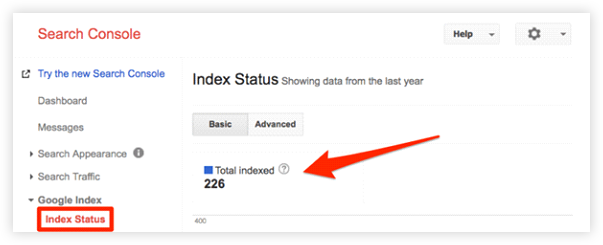
Another easiest way is using the Google search bar to find out the total indexed pages. Simply search with site:yourwebsitename.com, and this gives you the number of pages Google has indexed for your domain.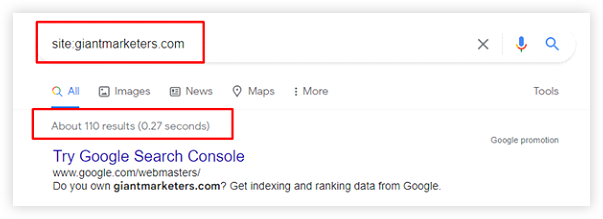
But, this method is not as accurate as of the Google search console. However, if you see that there are pages that are not indexed, that means there may be a problem in your robots.txt file. We’ll discuss it later in this guide. Also, maybe there are broken or improperly used links.
3. Make Sure You’re Ranking For Your Brand Name
Unless your site is absolutely new, it should come as the first organic result after searching with your brand name.
Once you search with your brand name if you see another site is ranking on #1, that means Google finds another site more appropriate than yours to rank for your brand term.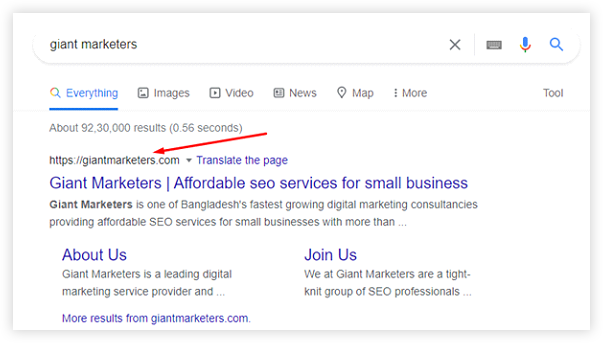
Here you can do the following things to solve this-
- Building some strong and powerful branded links;
- Running a PR campaign, for example, getting backlinks from well-known and authentic websites.
- Citations on business directories building
- Ensure Google Business listing;
- Make sure to have a strong presence on all the major social networks.
These will help your site gradually climb up the ranking position.
4. Analyze Keywords And Organic Traffic
Analyzing keywords and organic traffic helps you get a clear view of the specific keywords that bring the majority of organic traffic to your site. This will help you in 2 different ways, like-
- You’ll get a list of the most important and valuable keywords or pages where you can focus more, and
- Understand the kind of keywords that work for your audience, and this way, you can find more valuable keywords for your site, which can bring more traffic and sales.
In this step, you can use Google Analytics to break down your keyword performance. Here you just need to open the Acquisition breakdown up and select the organic search. Then from the channel breakdown page, select “Landing Page”.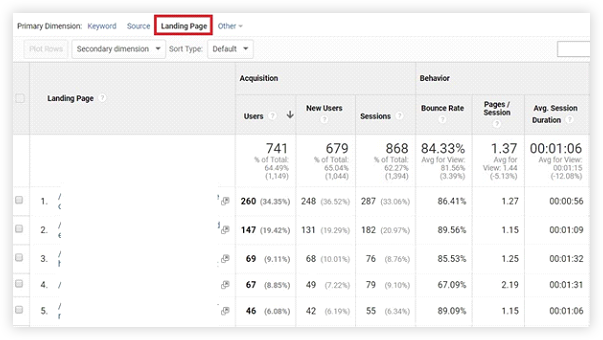
On this page, you’ll find an overview of the most important pages on your site for organic search. If you want more advanced metrics with detailed analysis, you can use other tools like Ahrefs, Moz, SpyFu, etc.
5. Evaluation Of Content
Content is what educates and engages audiences towards your site. It is like a king to any website; therefore, it’s essential to focus on your content strategy and conduct a full content audit. It includes checking how the website content is driving the business through organic visitors. Here, you should focus on-
- Finding low-quality pages with minimal or zero organic search traffic. (If these pages can be improved, you can focus on updating and relaunching them, otherwise, just remove or 3011 redirect the URL to relevant pages.)
- Check for duplicate or thin content, as these can damage your SEO efforts. Even you will get penalized by search engines with duplicate content. You should focus on producing high-quality and original content. Here you can rewrite or delete the duplicate post.
Another fact is thin content which means pages with very little written content. Thin content provides little to no value to no value to your site and even struggles to rank on the SERP as well.
6. Thorough Research Of Your Competitors
Auditing your competitor’s site or spying on them is the easiest way to find SEO opportunities and discover holes that exist in your site. It is one of the essential steps in your SEO audit process. In this process, you can use competitor analysis tools like SpyFu, Moz, SemRush, UberSuggest, etc.
- Make a list of your relevant competitors to your website.
- Find out the content gaps, which means keywords that your competitors are ranking for, but you don’t.
- Look out for the backlinks of your competitors; it can be the richest source of your new backlink opportunities.
- Check out your competitor’s strategy and plan to provide something better than them.
- Evaluate how your competitors are reaching organic traffic using different keywords.
You need to keep one thing in mind that your competitors are also doing the same things to grow their site and improve their digital marketing strategy. So, if you want to stand out from the crowd, you need to provide better than them, and to do so, you need a proper SEO audit of your competition.
7. Check For On-Page Optimization
An on-page audit will help you to make sure that the elements are in place that you need to optimize your site. So, you can start with the following question-
- Is your content optimized with NLP and EAT?
- Are your pages well-crafted and have clickable title tags?
- Does the page have a custom meta description? Is it optimized for maximizing CTR?
- Is there only one H1 tag? Is it well-optimized?
- Are subheaders (H2, H3, etc.) being used correctly?
- Do the URLs are well optimized for search engines?
You should focus on every aspect of your on-page SEO, as it can highly influence your ranking and user experience. Therefore, make sure to optimize all the on-page issues that you found in your SEO audit report. In general, on-page SEO includes the following-
- Content Optimization: While producing content, you should consider several things like considering EAT throughout your content. Also, make sure to optimize your content to make it SEO-friendly. You can use io or SEMrush’s SEO Writing Assistant to ensure SEO-friendly content.
Another fact is, all your content should be unique and absolutely plagiarism-free. Here you can use quetext.com, copyscape.com, etc.
- URL Structure: The URLs of your site should be short, distinct, and must include the target keyword.
- Headings: When writing content, you should always consider appropriately assigning header tags. It will make your pages well-organized and easier for the users to navigate. In fact, it helps Google to understand the concept of your page through these header tags.
So, there should be one H1 tag that will introduce the content topic or title. Then you should use H2 tags to describe the main topics of the content, and then respectively use the H3 to H6 tags as subsequent headers.
- Title and Meta Tags: You should carefully focus on both title and meta tags and ensure that they don’t get truncated on the search result. Both these should include the target keyword, short and to the point.
The perfect length for title tags is 60 characters and 155-160 characters for meta tags. While creating a title tag and the meta tag, you must avoid duplicate tags.
- Internal and External Links: You should use internal and external links to make your content more relevant and informative. While linking to your site’s other pages, make sure they are relevant and high-priority pages.
On the other side, while using external links, research properly and link to the authentic and most reliable sites.
- Image alt Tags: Google uses alt tags to understand what your content images are trying to convey. Without alt tags, Google can’t understand what your images are trying to describe. Therefore, make sure to use alt tags for every image and use your targeted keyword once for the feature image. Then you can describe the other images by optimizing the alt tags with a short description.
8. Look Out For The Backlink Strategy
Link building is a large part of your site that can make or break your site authority. The number of authentic and quality backlink you have, the more strongly it can correlate you with higher rankings.
Therefore, while conducting an Off-page audit, look out for backlinks with low-quality or purposely manipulative. Backlinks should come from sites with High authority, DA, PA, Traffic, Traffic quality, Traffic Graph, Backlink Profile. Also, the site should be highly relevant to your niche.
9. Find The Technical Errors
The technical factors help to make your site’s structure solid, improve the loading speed, and user experience. Without optimizing your site with all the technical SEO factors, you can’t rank high on the SERPs. Here, the Technical SEO Audit Service can help you to identify all the technical issues and optimize your site to improve them. This may include the following-
- txt: The robots.txt file instructs search engine crawlers to crawl your site’s specific pages or sections and specify which pages they can crawl and which not. So, if you mistakenly disallow any crucial page of your site, Google can’t crawl and index that page.
To avoid making any syntax error, you can use the SEOptimer, which is a robots.txt generator tool. Once placing the robots.txt file in your root directory, you can use robots.txt Tester by logging into the Google Search Console to see that everything is working correctly.
- XML Sitemap: Your website architecture or you can say that the list of your indexable pages are placed within the sitemap. Google uses an XML sitemap to index your pages. If you don’t have an XML sitemap or there is an issue in your sitemap Google will find it difficult to navigate and index your pages.
In that case, you can use the Screaming Frog sitemap generator tool to create your sitemap. Also, if you’re using WordPress, installing a plugin like Yoast or Google XML Sitemaps will help you to get started. Once your sitemap is ready, simply submit it to Google Search Console, and it’s done.
- SSL (Secure Socket Layer): Since 2014, Google has considered HTTPS as a ranking factor. Also, Google made the use of SSL and switch to HTTPS mandatory in 2018. So, still, if your site is not encrypted with HTTPS, get it as soon as possible.
- Page Speed: Loading page speed is one of the most crucial factors to ensure user experience and site ranking on the top. The minimum your site’s loading speed is, the more you can engage your audiences.
When conducting an SEO audit, you may find several issues which are affecting your site’s loading speed. To make your site load fast, make sure to minify CSS, HTML, and JS files, compress images, reduce redirects, reduce server response time, use CDN, browser caching, etc.
- Mobile-Friendliness: More than half of online searches are happening regularly from mobile devices. Therefore, it’s essential for your site to be optimized for mobile users. You can test your sites’ mobile-friendliness using Google’s Mobile-Friendly Test
Also, make sure to optimize your site for mobile users by integrating responsive web design, creating a separate mobile URL, and avoiding using pop-ups and flash for your mobile site.
- Fix Broken Links On Your Site: Broken pages are responsible for hampering your site’s UX/UI. Therefore, you need to find and fix these issues as soon as possible. To find out the broken links you can use the DrLinkCheck.com tool or Broken Link Checker plugin.
After identifying the broken internal links, you can replace them with the live links or simply can remove them if they are not worthy enough. To fix the broken external links, you should communicate with the site owner and request a fix. Also, you can look out if there is any mistake in changing the URL of a page and forgetting to redirect.
Is an SEO Audit Worth It?
An SEO audit can allow your business to start driving measurable results from your SEO strategies. To get the best result and make the most out of your SEO strategy, it’s definitely worth investing in a comprehensive and 360-degree SEO audit.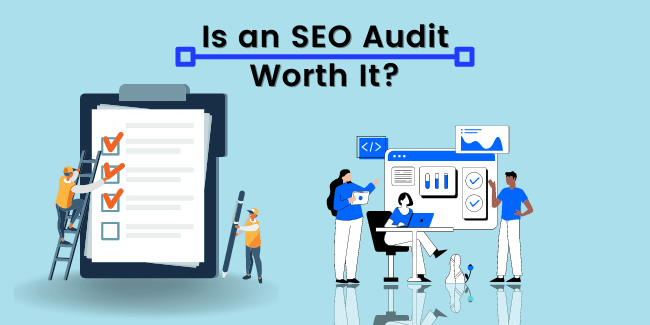
With regular SEO audits and updates of your site’s SEO strategy, your business can benefit in several ways. Let’s figure out how-
Enhance Your User Experience:
Do you know that almost 90% of consumers prefer a competitor to shop after seeing a negative UX? This implies if your site provides a bad user experience, that means you’re losing your valuable potential customers.
In this case, an SEO audit allows you to discover new ways that help to improve your site’s user experience. You can uncover opportunities to optimize your site for your customers. This way, you can make it easier for shoppers to build a strong relationship with your site and convert.
Improve Your Website’s Visibility:
We’ve mentioned earlier that an SEO audit provides insights into your site’s keywords strategy. So, this way, you can figure out the most and least valuable keywords. After that, you can refocus on your valuable keywords and increase rankings in search results for those specific keywords.
Maximize Your Site’s Traffic:
A study found that the #1 ranking position gets almost 33% of search traffic. Another study by Smart Insights found that the #1 position in Google search results gets 34.2% of search traffic. That means if you rank on the first page of the search results, you can start driving valuable traffic to your site.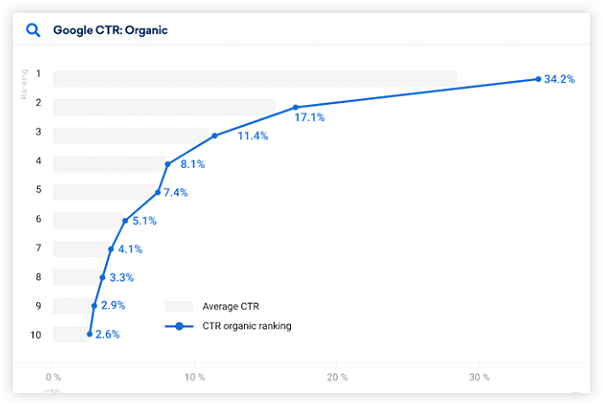
So, if you want to rank in the first position in the Google search result, you need to follow all the SEO best practices to maintain your site. And this can only be possible through an SEO audit.
Increase Your Sales And Revenue:
As we said before, based on the SEO audit, you can discover insights into your site’s keywords, including their performance and usefulness. In this way, you can work with more valuable keywords and drive more valuable traffic.
And when you can gain high-value traffic on your site, it’ll automatically increase your conversion rates, which will ultimately lead to driving more revenue for our company.
Optimize Your Digital Marketing Strategies:
SEO is all about a competitive and result-driven digital marketing strategy. You can easily maximize your investment and return with a robust strategy and implementation of SEO best practices. An SEO audit is the best way to uncover your digital marketing-related tactics improvements.
Restructure Or Fix Your SEO Strategy:
SEO is an ever-evolving process, and the dynamics and algorithms of SEO are constantly changing and updating. In this case, conducting SEO audits on a frequent basis can help you to get an in-depth assessment of your site’s current situation and SEO status. In fact, through the audit, you’ll get through recommendations for fixing your SEO issues and ways to improve them.
Start Boosting Your Google Ranking With an SEO Audit
We hope from this guide now you know how does SEO audit help boost Google ranking. If you want to boost your Google ranking, conducting an SEO audit would be a wise option for you. A great SEO strategy is all about consistency and optimizing the best practices according to Google’s guidelines.
Therefore, to ensure catching the errors as soon as they happen and stay on top of your SEO efforts, nothing can beat the necessity of an SEO audit. So, make sure to run an SEO audit on your site regularly, track the results, consider the recommendations, implement them, and improve your site’s performance.
So, if you find this guide useful, make sure to share your thoughts by commenting below. Also, if you have any queries related to this topic you can ask us, we’ll be glad to solve them out.


